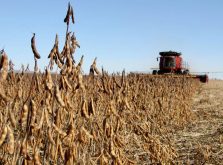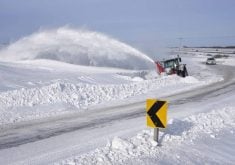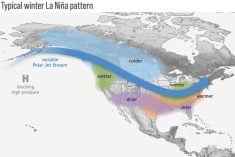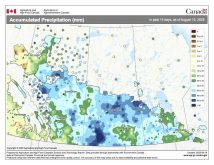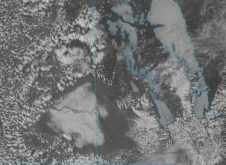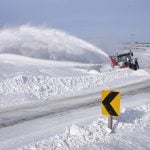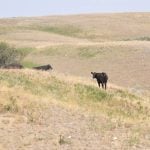Table 1. Holiday averages
Dec. 24-26
Dec. 31-Jan. 1
Average high
-10C -12C
Average low
-20C
-22C
Average mean
-15C -17C
Table 2. Historic data for Winnipeg, Brandon and Dauphin
Date
24
25
26
31
1
24
Record max (C)
3.9
5.4
2.8
2.8
4.4
4.4
25 26 31 1
8.3
Read Also

October rain recharges Manitoba soils
Daniel Bezte looks back on October weather on the Prairies and looks ahead to see whether there’s any consensus for this winter’s weather.
24 25 7.2 26 8.3
31
Year
7.2 1999 -40.0
4.8 2005 -39.4
Winnipeg (1872-2008)
1953
1999
1956
1896
1880
BRANDON (1890-2008)
1953
Record min (C)
5.0
5.6 1953 -41.1 1946
5.0 1927 -40.0 1901
DAUPHIN (1890-2008)
1963
-47.8
-40.0
-38.9
-38.8
-43.3
-41.0
-37.8
1919 1999 -33.9 1919 -37.2
-38.3
Year
1879
1873
1883
1884
1885
1983
1902 1891
1984 1960
1968 1973
Record ppt (mm)
15.2
9.4
30.5
14.5
14.0
5.1
15.2 7.6
10.2 14.6
12.7 4.6 7.6
20.3
Year
1929
1938
1916
1965
2005
1938
1938 1976
1940 2005
1911
1963 1906
1907
Every year just before Christmas I like to take a look at the weather statistics for the holiday season. Since the “numbers” don’t change a lot from year to year some of these statistics might look a little familiar from previous years, but in staying with tradition I have done a little tweaking with the way we will look at the numbers.
This year I have gone back as far as records go for each of our three main stations (Dauphin, Brandon, and Winnipeg). Some people might argue that the really old records don’t count, as conditions have changed significantly around these places, but I say what the heck, we just want to know what the all-time records are for these locations – we aren’t doing climate research here!
Now, before we look at these values we need some kind of baseline to compare them to. That is, what are the average temperatures we should expect between Dec. 24 and 26, along with Dec. 31 and Jan. 1? The averages for all three stations were pretty close so we can pretty much just go with one set of numbers, as seen in Table 1.
Those temperatures are not too bad, but remember, those are the averages, which mean that about half the time, we’re colder than that!
In Table 2 I’ve placed all the records for these dates, along with the length of record for each station. The precipitation data is the amount of liquid we would get if the snow was melted. Snowfall amounts are usually around 10:1, which means that for every 10 centimetres of snow we would get one cm (10 millimetres) of liquid water. Snowfall ratios can be as high as 20:1.
From the data we can see that the most significant snowfall event over the holiday season (at least these dates) occurred in Winnipeg on Boxing Day back in 1916, when over 30 cm of snow fell (another five cm fell on the 27th). Dauphin had the next biggest dump of snow, with over 20 cm falling on New Year’s Eve back in 1907. Environment Canada’s database does show 50 cm of snow falling on Dauphin on the 31st back in 1994, but I am not sure how much I can trust this data. Most of the data for that month is missing and it shows the high on that day of 0C and a low of -30C, which is kind of suspect. I also checked stations around Dauphin and none of them recorded any snow.
When we look at the temperature records a couple of things jump out at me. First of all, if you don’t like it getting colder than -40C, then head to Dauphin, as none of the records there are below -40C. The other thing that jumped out at me is that while Winnipeg has some extremely cold records over the holiday season, they are all very old records dating back to the 1870s and 1880s.
Will we be challenging any of the weather records this holiday season? I wouldn’t bet my turkey on it. The weather pattern looks to remain fairly quiet over the next couple of weeks with no major storms forecast to be in our neighbourhood and no signs of any major warm-or cold-air outbreaks. No matter what the weather does bring this year, I hope everyone has the very best Christmas and a happy New Year.



